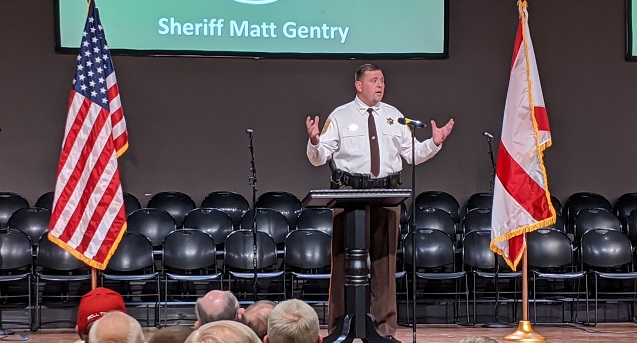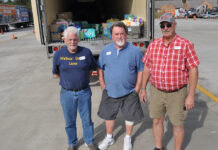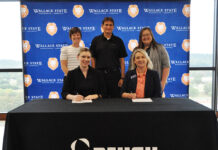
CULLMAN, Ala. – On Thursday evening, the Cullman County Sheriff’s Office (CCSO) held its third church safety class, a program that began following the tragic November 2017 mass shooting at First Baptist Church in Sutherland Springs, Texas which left 26 worshipers dead.
On Nov. 5, 2017, Devin Patrick Kelley drove into the church parking lot, fully prepared to wreak havoc with multiple firearms, plenty of ammunition, ballistic armor and a plan of attack. The congregation was caught completely off guard. Kelley walked up and down the aisles, shooting at will. He died after exchanging shots with a community resident as he was leaving the church.
In contrast, on Dec. 29, 2019, when Keith Thomas Kinnunen walked into West Freeway Church of Christ in White Settlement, Texas and drew a gun, an organized volunteer security team reacted swiftly. Two members of the congregation died; one was a security team member who drew the assailant’s attention by screaming and drawing his own pistol. Jack Wilson, head of the security team, shot and killed Kinnunen. The assault was over in six seconds.
The difference was preparation and a combination of capability and willingness to act.
What is happening?
In a conversation with The Tribune, Cullman County Sheriff Matt Gentry was asked if, when he got into law enforcement more than 20 years ago, he envisioned himself ever teaching churchgoers how to defend themselves against assaults on their places of worship.
Gentry responded: “No. It was something that, 20 and a half years ago, we never thought about or would have ever thought we would have to be doing today.”
What has changed?
“I just see the moral values of people, over the last 20 and a half years, have changed. We are blessed to live in Cullman County where we still have very strong moral values about right and wrong and doing what’s right, a strong community that believes in doing what’s right.
“You know, we’re not immune by any means. We have issues that will arise, but we’re blessed here because of our citizens. Our citizens, bar none, are the best there is in the state and the country, in my opinion, but, like any good community, you need to prepare for the worst. That’s what these classes are: is the sheriff’s office and the community coming together, preparing for the worst, praying for the best-which is that we never have to face this, but coming together as one to prepare for the worst.”
CCSO Deputy Chad Whaley and Investigator Trevor Clemmons Thursday night walked a large audience through plans for making facilities more secure up front, and for responding to immediate threats in a manner as organized and safe as possible.
Instructors recommended the development of a church safety plan including:
- A site survey of church property: lighting, door locks, door barricades, fire/smoke alarm systems, availability of safety exits, video security cameras, public address systems or alarm buzzers/bells, and auto-text messaging to smart phones to post alerts for emergency instructions
- A medical alert team that is made up of members with medical training (medical doctors, RNs, EMTs, or others) who can respond to medical emergencies
- A security response team. These members must be trained and have the physical ability to safely remove a person who is disorderly, possibly mentally disturbed, or aggressive who has come to disrupt services or attack a member.
- A system of layered security made up of greeters, ushers or monitors that meets and subtly screens worshipers for persons who might pose a threat to others. The monitors would also protect parking lots, entrances and exits, and would watch over the facility while worship services or events are taking place.
Clemmons talked about the importance of having a church safety team, and of having that team properly trained. He then covered safety and security tools, including the safe and legal use of firearms and deadly force.
His watchwords were “Train and practice.”
Gun safety
Church leaders preparing to respond to an attack must decide if they will respond in force, and if so, how. Will security team members use non-lethal means like pepper spray or batons/canes? Will they use firearms, and will others be allowed to carry them into the church building?
If firearms are to be allowed, “four cardinal rules of firearms safety” govern their handling and use:
- Treat all guns as if they are loaded.
- Keep the gun pointed in a safe direction.
- Keep your finger outside the trigger guard until you are on target and have decided to fire.
- Be sure of your target, what is around it, and what is beyond it.
Clemmons advised church leaders and planners to ask these questions:
- Are side rooms or hallways locked to prevent the auditorium or sanctuary from being entered without being observed?
- Are doors marked with signs to let visitors know what door to enter once services start?
- Is there a way to contact staff quickly in an emergency?
- Are there any hazards in hallways or evacuation routes that need to be cleared?
- Are there any areas for concealment or furniture that could provide short-term barricades?
- Who would confront a threat and who would direct others to safety?
- Are nurseries, youth areas or Sunday school classes monitored? Are the doors to those rooms locked? Are the teachers aware of the safety team’s plan? How would the teachers notify the safety team in an emergency?
A.L.I.C.E.
Historically, people have been told to wait on the police to arrive during emergencies. These days, authorities go in the opposite direction, telling people in harm’s way to take action: literally fight or flight.
According to Whaley, an assailant must have two things: something to shoot at and time to shoot. His presentation centered on the A.L.I.C.E. program used for school security all over the country, including Cullman County’s schools, saying that the plan takes one or both of those elements away from the shooter.
The program, designed as a response to active shooter emergencies, emphasizes five points:
A – ALERT – An alert, alarm, public address, text or call must be made to let members know an emergency is happening. Call 911 as soon as possible for immediate response, and the church should have medical supplies available to give first aid until help arrives.
L – LOCKDOWN – As soon as the emergency is discovered, immediately secure and lock entrances, classrooms, nurseries, offices and hallways to prevent intruders from gaining access.
I – INFORM – Notify everyone that a threat exists, and give a specific location if possible.
C – COUNTER – Try to stop the threat, disrupt and distract the attacker’s attention and thought processes (throwing things, making noise, etc.), attack the attacker, disarm them, disable them or physically restrain them until help arrives.
E – EVACUATE – Get everyone out of the endangered area safely. Make plans for the elderly, disabled, small children or babies in nurseries so that they may be escorted. Make sure people know about a predetermined reunification area where family members can meet them after an evacuation, whether it is in another building or alternate location.
If you couldn’t make it to the class, or want more help
The CCSO has visited almost 100 churches across Cullman County in the last two years, walking through facilities and helping congregational leaders develop individualized plans to make their buildings and activities safer and more secure. To schedule a visit to your church, contact Deputy Bradley Williams at 256-734-0342 or bwilliams@cullmansheriff.org.
Copyright 2020 Humble Roots, LLC. All Rights Reserved.


























